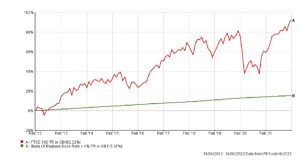
The tension between Russia and the West over Ukraine has been building in recent weeks, and Russia’s incursion into Ukraine has clearly escalated the crisis. We explain why investors should stay calm and why we feel there are good reasons to take an optimistic view.
Likely fallout from the crisis
So far, 2022 has seen investment markets give back some of the gains made in 2021, firstly due to higher levels of inflation, and secondly as a result of the increased tensions between Russia and Ukraine. Whilst most global markets have seen modest falls over the year to date, as ever, it is important to take a rational look at events, and consider the bigger picture for investment markets over the remainder of this year and beyond.
As a direct consequence of the increased tensions, oil prices have climbed, breaching the $100 a barrel mark. Higher energy costs are likely to exacerbate the inflationary pressure in the short term; however, our view remains that inflation will moderate as we head towards the end of the year. Naturally, the higher oil price is likely to benefit oil producers and energy companies generally. Likewise, the imposition of sanctions on Russia and Russian interests by the West could lead to further falls in Russian equities, and the value of the Russian rouble. For this reason, we would recommend investors favour developed markets rather than emerging markets in these conditions.
Reasons to be optimistic
To counter the potential downsides of the increased tension, there are a number of good reasons to be positive despite the newsflow. With Covid-19 restrictions easing around the world, the headwinds from the Coronavirus pandemic are starting to subside, which should allow Western economies to continue to grow over the remainder of 2022. Apart from a small number of recent disappointments such as results announced by Meta (Facebook) and Peleton, corporate earnings have generally matched or beaten market expectations over recent months, and forecasted profits remain strong in many sectors of the economy.
Another reason for optimism is that markets have already fallen back over the last six weeks and may, to some extent, have already priced in some of the potential risk from further escalation of the Russian incursion.
Finally, the increased geopolitical risk could potentially lead central banks to take a more measured view over the pace of interest rates increases over the remainder of 2022. Markets would almost certainly view this in a positive light.
Volatility is part of the process
Global markets are digesting a regular stream of news from events in Russia and Ukraine, which is likely to lead to continued volatility in the short term. Volatility is a measure of how much an asset rises or falls in value over a given period of time, and all of our investment strategies focus on limiting investment volatility over the longer term.
It has been noticeable that volatility has not increased significantly over recent weeks and overall levels of volatility are significantly lower than levels seen at the beginning of the pandemic in March 2020. We see this as a positive sign that market participants are prepared to take a measured view of events.
Learning from the past
Many investors will clearly recall the market gyrations seen at the start of the pandemic just less than two years ago. We counselled clients at that time to stay calm and remain invested through the very high levels of volatility seen at the time. Of course, history tells us that this was a sensible course of action to take as global markets had recovered their losses by the end of 2020.
Similarly, we avoided recommending clients take action to try and trade the volatility seen at the time, and this remains our recommended course of action now. To quote an often used market adage “it is time in the markets, not timing the markets” that produces long-term returns.
Furthermore, investment should always be viewed as a medium to long term process, and investor focus should always remain on the longer term goals and outcome, rather than short term fluctuations in market conditions.
Review your portfolio
Diversification is a key part of our investment process, and for many investors should be a cornerstone of portfolio construction. Holding too much exposure to any one area or asset class can lead to greater than expected volatility, which can be reduced by spreading funds across a range of different assets, sectors and geographies. If your portfolio is not regularly reviewed, our experienced team at FAS would be happy to take an impartial review of your investments, to consider how they are invested and the level of diversification.
Stay the course
From a global security point of view, it is clearly unsettling to see the destabilising effects of the military action. However, when it comes to investment strategy we recommend that investors remain calm and focused on the wider economic outlook. Naturally, the team at FAS will continue to monitor markets closely as the situation unfolds.
If you are interested in discussing the above with one of our experienced financial planners, please get in touch here.
The value of investments and the income they produce can fall as well as rise. You may get back less than you invested. Past performance is not a reliable indicator of future performance. Investing in stocks and shares should be regarded as a long term investment and should fit in with your overall attitude to risk and your financial circumstances.








